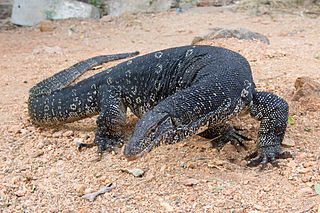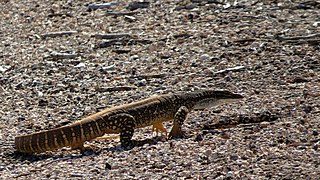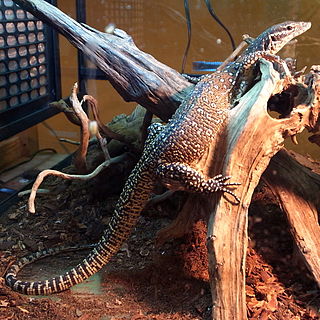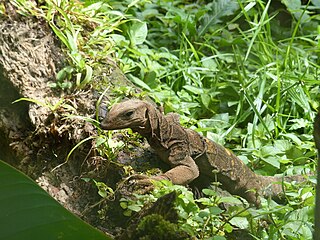
Monitor lizards are lizards in the genus Varanus, the only extant genus in the family Varanidae. They are native to Africa, Asia, and Oceania, and one species is also found in the Americas as an invasive species. About 80 species are recognized.

André Marie Constant Duméril was a French zoologist. He was professor of anatomy at the Muséum national d'histoire naturelle from 1801 to 1812, when he became professor of herpetology and ichthyology. His son Auguste Duméril was also a zoologist, and the author citation Duméril is used for both André and his son.

The Asian water monitor is a large varanid lizard native to South and Southeast Asia. It is widely considered to be the second-largest lizard species, after the Komodo dragon. It is distributed from eastern and northeastern India and Bangladesh, the Andaman and Nicobar Islands, Sri Lanka, through southern China and Hainan Island in the east to mainland Southeast Asia and the islands of Sumatra, Borneo, Java, Lombok, the Riau Archipelago, Sulawesi. It is one of the most widespread monitor lizards.

The sand goanna, also known commonly as Gould's monitor, the racehorse goanna, and the sand monitor, is a species of large Australian monitor lizard in the family Varanidae.

The black tree monitor or Beccari's monitor is a species of lizard in the family Varanidae. The species is a relatively small member of the family, growing to about 90–120 cm (35–47 in) in total length. V. beccarii is endemic to the Aru Islands off New Guinea, living in an arboreal habitat. The skin color of adults is completely black, to which one common name refers.

The mangrove monitor, mangrove goanna, or Western Pacific monitor lizard is a member of the monitor lizard family with a large distribution from northern Australia and New Guinea to the Moluccas and Solomon Islands. It grows to lengths of 3.5 to 4 ft. It is also known as wbl yb in the Kalam language of Papua New Guinea.

The emerald tree monitor or green tree monitor, is a small to medium-sized arboreal monitor lizard. It is known for its unusual coloration, which consists of shades from green to turquoise, topped with dark, transversedorsal banding. This coloration helps camouflage it in its arboreal habitat. Its color also makes the emerald tree monitor highly prized in both the pet trade and zoos alike.

The yellow-spotted monitor, also known as the Argus monitor, is a monitor lizard found in northern and western regions of Australia and southern New Guinea.

The spiny-tailed monitor, also known as the Australian spiny-tailed monitor, the ridge-tailed monitor the Ackie dwarf monitor, and colloquially simply ackie monitor, is an Australian species of lizard belonging to the genus of monitor lizards (Varanus).

The rock monitor is a species of monitor lizard in the family Varanidae. The species is endemic to sub-Saharan Africa, where, on average it is the largest lizard found on the continent. It is called leguaan or likkewaan in some areas.

The peacock monitor, also known commonly as Auffenberg's monitor, is a species of small monitor lizard in the family Varanidae. The species, which belongs to the subgenus Odatria, is endemic to Rote Island, Indonesia.

The black rough-necked monitor is a species of monitor lizard found in Southeast Asian countries of Thailand, Burma, and Malaysia. It is also found in Indonesia on Sumatra and islands of the Riau Archipelago It is sometimes known simply as the roughneck monitor. In Thailand is called h̄èā cĥāng.

The blue-tailed monitor, blue-tailed tree monitor or Kalabeck's monitor, is a monitor lizard of the Varanidae family. It belongs to the V. doreanus group of the subgenus Euprepiosaurus.
Varanus keithhornei, commonly known as the canopy goanna, Keith Horne's monitor, blue-nosed tree monitor, or Nesbit River monitor, is a species of monitor lizards native to northeast Australia. It is a member of the Varanus prasinus species group.
Finsch's monitor is a species of monitor lizard in the family Varanidae. The species is native to New Guinea and Australia.

Varanus kordensis, the Biak tree monitor, is a member of the Varanidae family found on Biak Island in Indonesia. It is also known as the Kordo tree monitor. Long considered a subspecies of the emerald tree monitor, most authorities now treat it as a separate species.

The marbled water monitor, also known commonly as the Philippine water monitor, is a large species of monitor lizard in the family Varanidae. The species is endemic to the Philippines.
Varanus zugorum, also known commonly as the silver monitor or Zugs' monitor, is a species of monitor lizard in the family Varanidae. The species is endemic to the island of Halmahera in the Moluccas, in Indonesia.

Varanus spinulosus, the Solomon Island spiny monitor, Isabel monitor, or spiny-neck monitor, is a species of monitor lizard. It is endemic to the Solomon Islands archipelago and is also known from Santa Isabel Island, San Jorge Island and Bourgainville Island.
Bogert's monitor is a species of tree-dwelling monitor lizard. The species is native to Papua New Guinea.




















